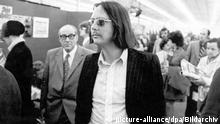David Warren "Dave" Brubeck (December 6, 1920 – December 5, 2012) was an American jazz pianist and composer, considered to be one of the foremost exponents of progressive jazz. He wrote a number of jazz standards, including "In Your Own Sweet Way" and "The Duke". Brubeck's style ranged from refined to bombastic, reflecting his mother's attempts at classical training and his improvisational skills. His music is known for employing unusual time signatures, and superimposing contrasting rhythms, meters, and tonalities.
His long-time musical partner, alto saxophonist Paul Desmond, wrote the saxophone melody for the Dave Brubeck Quartet's best remembered piece, "Take Five",[1] which is in 5/4 time and has endured as a jazz classic on one of the top-selling jazz albums, Time Out.[2] Brubeck experimented with time signatures throughout his career, recording "Pick Up Sticks" in 6/4, "Unsquare Dance" in 7/4, "World's Fair" in 13/4, and "Blue Rondo à la Turk" in 9/8. He was also a respected composer of orchestral and sacred music, and wrote soundtracks for television such as Mr. Broadway and the animated mini-series This Is America, Charlie Brown.
Brubeck was born in the San Francisco Bay Area city of Concord, California,[1] and grew up in Ione. His father, Peter Howard "Pete" Brubeck, was a cattle rancher, and his mother, Elizabeth (née Ivey), who had studied piano in England under Myra Hess and intended to become a concert pianist, taught piano for extra money.[3] His father had Swiss ancestry (the family surname was originally "Brodbeck"), while his maternal grandparents were English and German, respectively.[4][5][6] Brubeck originally did not intend to become a musician (his two older brothers, Henry and Howard, were already on that track), but took lessons from his mother. He could not read sheet music during these early lessons, attributing this difficulty to poor eyesight, but "faked" his way through, well enough that this deficiency went mostly unnoticed.[7]
Intending to work with his father on their ranch, Brubeck entered the College of the Pacific in Stockton, California (now the University of the Pacific), studying veterinary science, but transferred on the urging of the head of zoology, Dr. Arnold, who told him "Brubeck, your mind's not here. It's across the lawn in the conservatory. Please go there. Stop wasting my time and yours".[8] Later, Brubeck was nearly expelled when one of his professors discovered that he could not read music. Several of his professors came forward, arguing that his ability with counterpoint and harmony more than compensated. The college was still afraid that it would cause a scandal, and agreed to let Brubeck graduate only after he had promised never to teach piano.[9]
After graduating in 1942, Brubeck was drafted into the army and served overseas in George Patton's Third Army. He was spared from service in the Battle of the Bulge when he volunteered to play piano at a Red Cross show; he was such a hit he was ordered to form a band. Thus he created one of the US armed forces' first racially integrated bands, "The Wolfpack".[9] While serving in the military, Brubeck met Paul Desmond in early 1944.[10] He returned to college after serving nearly four years in the army, this time attending Mills College in the San Francisco Bay Area and studying under Darius Milhaud, who encouraged him to study fugue and orchestration, but not classical piano. While on active duty, he received two lessons from Arnold Schoenberg at UCLA in an attempt to connect with High Modernism theory and practice.[11] However, the encounter did not end on good terms since Schoenberg believed that every note should be accounted for, an approach which Brubeck could not accept.
After completing his studies under Milhaud, Brubeck helped to establish Berkeley, California's Fantasy Records. He worked with an octet (the recording bears his name only because Brubeck was the best-known member at the time), and a trio including Cal Tjader and Ron Crotty. Highly experimental, the group made few recordings and got even fewer paying jobs. The trio was often joined by Paul Desmond on the bandstand, at Desmond's own insistence.[citation needed]
In 1949, Jack Sheedy, the owner of a San Francisco-based record label called Coronet, was talked into making the first recording of Brubeck's octet and later his trio. (This Coronet Records should not be confused with either the late 1950s New York-based budget label, nor the Australia-based Coronet Records.) Sheedy's label had previously recorded area Dixieland bands, but Sheedy was unable to pay his bills and in 1949 turned his masters over to his record stamping company, the Circle Record Company, owned by Max and Sol Weiss. The Weiss brothers soon changed the name of their business to Fantasy Records and met an increasing demand for Brubeck recording by recording and issuing new records. Soon the company was shipping 40,000 to 50,000 copies of Brubeck recording a quartet, making enormous profits.[12]
Quartet era
When Brubeck signed with Fantasy Records, he thought he had a half interest in the company and he worked as a sort of A & R man for the label, encouraging the Weiss brothers to sign other contemporary jazz performers, including Gerry Mulligan, Chet Baker and Red Norvo. When he discovered that all he owned was a half interest in his own recording, he was more than willing to sign with another label, Columbia Records.[14]
In 1951 Brubeck damaged his spinal cord and several vertebrae, while diving in the surf in Hawaii. He himself said that the paramedics who attended had described him as a "DOA" (dead on arrival). Brubeck recovered after a few months, but suffered withresidual nerve pain in his hands for years after.[15]
In 1954, he was featured on the cover of Time (magazine), the second jazz musician to be so honored (the first was Louis Armstrong on February 21, 1949[16]). Brubeck personally found this accolade embarrassing since he considered Duke Ellington more deserving of it and was convinced that he had been favored for being Caucasian.[17]
Early bassists for the group included Ron Crotty, Bob Bates, and Bob's brother Norman Bates; Lloyd Davis and Joe Dodge also held the drum chair. In 1956 Brubeck hired drummer Joe Morello, who had been working with Marian McPartland; Morello's presence made possible the rhythmic experiments that were to come. In 1958 African-American bassist Eugene Wright joined for the group's US State Department tour of Europe and Asia. Wright became a permanent member in 1959, making the "classic" Quartet's personnel complete. During the late 1950s and early 1960s Brubeck canceled several concerts because the club owners or hall managers continued to resist the idea of an integrated band on their stages. He also canceled a television appearance when he found out that the producers intended to keep Wright off-camera.[citation needed]
In 1959 the Dave Brubeck Quartet recorded Time Out, an album about which the record label was enthusiastic but which they were nonetheless hesitant to release. Featuring the album art of S. Neil Fujita, the album contained all original compositions, almost none of which were in common time: 9/8, 5/4, 3/4, and 6/4 were used inspired by Eurasian folk music they experienced during that US State Department sponsored tour.[18] Nonetheless, on the strength of these unusual time signatures (the album included "Take Five", "Blue Rondo à la Turk", and "Three To Get Ready"), it quickly went platinum. It was the first jazz album to sell more than a million copies.[19]
Time Out was followed by several albums with a similar approach, including Time Further Out: Miro Reflections (1961), using more 5/4, 6/4, and 9/8, plus the first attempt at 7/4; Countdown: Time in Outer Space (dedicated to John Glenn) (1962), featuring 11/4 and more 7/4; Time Changes (1963), with much 3/4, 10/4 (which was really 5+5), and 13/4; and Time In (1966).
These albums (except the last) were also known for using contemporary paintings as cover art, featuring the work of Joan Miró on Time Further Out, Franz Kline on Time in Outer Space, and Sam Francis on Time Changes.
A high point for the group was their 1963 live album At Carnegie Hall, described by critic Richard Palmer as "arguably Dave Brubeck's greatest concert".
TÍTULO: HOY CUMPLEAÑOS PETER HANDKE ESCRITOR 70,.
Ha escrito bestsellers, ha insultado al público y ha roto tabúes
políticos. Peter Handke, uno de los escritores más importantes de la
literatura en lengua alemana, cumple 70 años.
Cuando hizo su aparición en la escena literaria, los escritores todavía
llevaban gafas de carey y trajes. Las brumas de los años de la posguerra
cubrían Alemania, y un joven provinciano y enjuto, de chaqueta de cuero
raída y pelo largo, conmocionó el medio literario. Acusó a la
literatura alemana de “impotencia descriptiva” y se convirtió poco
después, con su obra de teatro “Insultos al público” en el enfant terrible de la literatura.La provocación como programa
Joven e irrespetuoso, un Handke de 25 años causa revuelo en los círculos literarios y sus gestos provocantes lo acompañan y marcan su imagen. En sus libros mezcla a Nietzsche con textos de canciones de rock y escribe sobre sus raíces eslovenas. Con los años, su propia vida se vuelve su fuente de inspiración. El cuento “Wunschloses Unglück” (1972), Desgracia impeorable, en el cual elabora el suicidio de su madre, sigue siendo un uno de los más fascinantes y conmovedores a través de sus cuestionamientos, sus frases inconclusas, sus dudas.
En los años 80 y 90 sus libros ya estaban por doquier. “El miedo del arquero ante el tiro penal” se convirtió en lectura obligada en las escuelas. Tradujo, trabajó como director de cine, escribió el guión para “Der Himmel über Berlin” (El cielo sobre Berlín), de su amigo Wim Wenders. Finalmente, al parecer, el mismo autor se cansó de tanta actividad; el revolucionario se había convertido en un literato reconocido y galardonado, entre otros, con el famoso premio alemán Georg-Büchner.
Grandeza y errores
Como si hubiera querido –una vez más- conjurar al duende de lo incómodo y clavar una espina en la moderación social, en 1996 Handke tomó una posición política que para muchos fue equivocada. Después de la separación de Yugoslavia, el escritor tomó partido por Serbia y protestó por el bombardeo de la OTAN. Visitó al presunto criminal de guerra Radovan Kardzic y la tumba de Slobodan Milosevic. Y escribió sobre ello.
Su crónica de viaje "Eine winterliche Reise zu den Flüssen Donau, Save, Morawa und Drina oder Gerechtigkeit für Serbien", Un viaje de invierno a los ríos Danubio, Save, Morava y Drina, o justicia para Serbia, fue despedazado por las críticas. La Comedie Francaise de París canceló una puesta en escena de una obra de Handke, y en 2006 hubo un gran escándalo por que le habían concedido el premio Heinrich Heine. Finalmente, Peter Handke renunció voluntariamente al galardón.
¿Un gran escritor puede permitirse grandes errores? ¿Es Handke un reaccionario político o un poeta con ganas de provocar y de torpedear la unanimidad pública? El escritor siempre se negó a dar una respuesta; se recluyó en su casa de París y da muy raras veces una entrevista.
En el 2008 apareció su libro “Die morawische Nacht” (La noche de Moravia), la historia de una odisea por Europa en busca de la propia vida. La rigidez política cede el paso en esta obra a una autorreflexión poética. Parece que Handke hubiese querido espantar los malos espíritus de los últimos años.
Su lenguaje coloca a la poesía en los entresijos, en los espacios intermedios. La distancia se mantiene siempre, las cosas se observan desde el margen, pero lo más íntimo y personal aflora: es ésta la contradicción que siempre ha caracterizado tanto la obra y la persona de Peter Handke, que cumple 70 años y sigue siendo un gran e incómodo escritor.




No hay comentarios:
Publicar un comentario